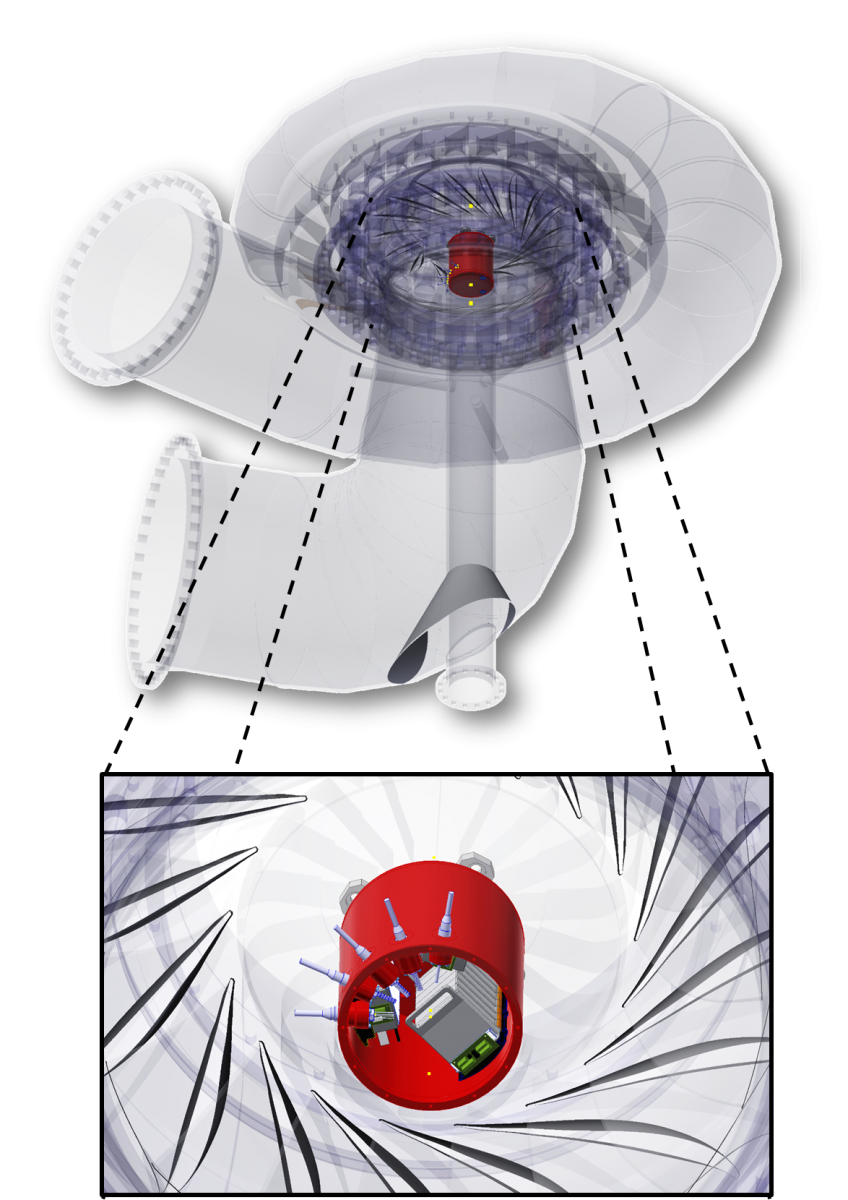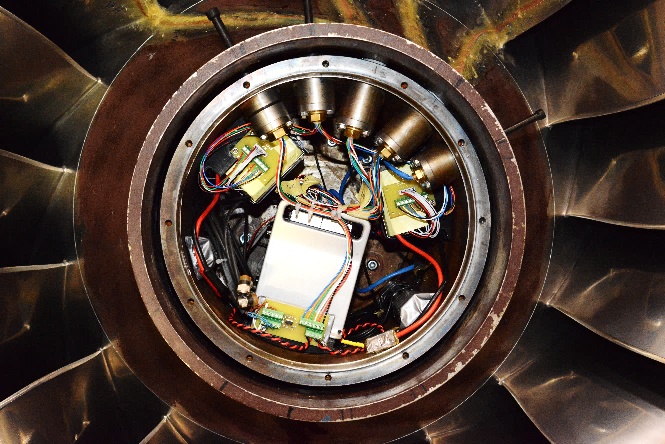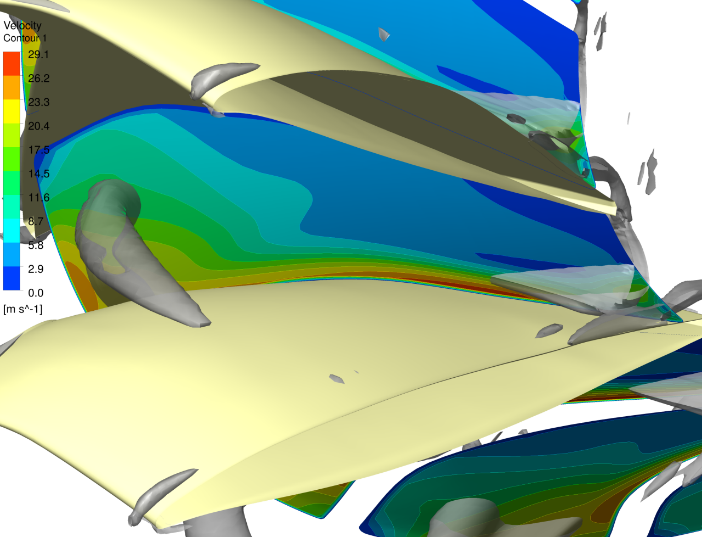The CTI (No. 17902.3 PFEN-IW-FLEXSTOR) research project FlexSTOR, standing for “Solutions for flexible operation of storage hydropower plants in changing environment and market conditions”, brought together the SCCER-SoE research partners and KWO to improve the climate and market resilience, as well as eco-compliance of Switzerland. New tools and methodologies were proposed for design and operation of flexible hydropower schemes and applied to KWO's power plants. To address this challenge, six main activities have been defined:
- WP1 - Hydropeaking mitigation
- WP2 - Impulse waves
- WP3 - Management of storage reservoirs in changing climate and market conditions
- WP4 - Sediment cascade flushing
- WP5 - Turbine abrasion
- WP6 - Unstable turbine behaviour at start/stop
The Hydroelectricity research group from the HES-SO Valais-Wallis was in charge of the FlexSTOR WP6 activities, together with KWO and EPFL-LMH, aimed at investigating the impact of frequent start-up and stand-by operation on hydraulic machines using numerical and experimental approaches, which are on the cutting edge of present developments.
In the recent years, due to the development and the integration of renewable energy resources, hydraulic turbines and pump-turbines are key technical components to stabilize the electrical grid. To act as grid stabilizer, the hydraulic machines must extend their operating range, cope with frequent start-up and stand-by operation while improving its long-term availability. The research activities, which led in the framework of WP6, aimed at studying a specific power plant facing such harsh operating conditions to:
- establish a hydrodynamic instability level hill-charts of the machine based on several monitoring parameters;
- propose alternative less-harmful start-up paths and stand-by positions with direct effect on the long-term maintenance costs;
- elaborate a diagnosis protocol to redraw hydrodynamic instability level hill-charts for different hydropower units, considering a simplified instrumentation set.
The case study focused on the pump-turbines of the hydropower plant Grimsel 2. The units are horizontal ternary groups with a complete motor-generator coupled with a Francis turbine on one hand and a single stage radial pump on another hand. The main efforts were dedicated to the investigation of the turbine mode. The phenomenon at the origin of the cracks observed on the turbine runner was not yet understood. The present study aimed at finding out the origin of this phenomenon and providing a way to diminish or cancel the risk of blade cracks in the future.
A first experimental campaign has been performed on the turbine of the unit 2 in November 2016. The rotating and the stationary frame instrumentation have been deployed. In addition to the normal start-to-stop cycles and the full operating range, three alternative slower turbine start-up procedures and one standard pump start-up procedure have been investigated.
A second campaign has then been performed in June 2017 (on the same unit 2). An upgraded mounting system for the on-board instrumentation has been set up. Different start-up procedures have been tested again. Both rotating and stationary frame measurements were successfully performed. The analysis of the results allowed us identifying the harsh operating conditions for the turbine.
Meanwhile, a complete numerical computational model of the turbine has been set up. More than ten numerical simulations, steady and unsteady, have been carried out for the best operating conditions area. The idea was to compare the numerical results to the existing available data to ensure the quality of the set up before launching more complex operating points. The matching was rather good but a discrepancy on the guide vane opening of one degree has been observed. The measurements of this parameter during the 2nd experimental campaign has been performed to clarify this point which is quite important once operating conditions at small opening angle are considered. Then the SNL point, reached during the start-up and shut down procedures has been numerically investigated using unsteady CFD and FEM simulations.
Finally, a third campaign has been performed in September 2018 on the turbine of the unit 4. The testing program focused mainly on the operation of the turbine during start-up in turbine and pump modes, nominal condition as well as the full operating range for a given testing head condition. The operation at very deep turbine part load as well as a regular and a shorter shut down procedure have also been addressed. The instrumentation has been composed only by the acquisition system installed in the stationary frame, several types of non-intrusive sensors being employed. The analysis of the results allowed us to check the capability of the non-intrusive detection for such diagnostics and to evidence the existence of the identified problematic on a different machine.
The defined goals of the project have been largely successfully accomplished. The main achievements of this work package are:
- Detailed review of the given problematic: analysis of the history of the unit, listing of evident excitation sources and of possible harsh conditions, collection of available data (geometry, history of operating points, maintenance, etc.).
- Development of an adapted investigation methodology: listing of adapted investigation tools to cope with the defined partial and final objectives; selection of a reference operating condition specific to the investigated unit.
- Advanced numerical CFD & FEM investigation: numerical identification of the Eigen modes of the turbine runner, fatigue simulation using data from measurements, steady & unsteady flow simulations validated with the statistical data (from SCADA) and with in-situ measurements.
- Challenging onboard measurements: setup of a reusable robust autonomous measurement system using a synchronous acquisition of signals from strain gauges, accelerometers and tachometers. Dealing with particular hard conditions: 17 bars of static pressure, high centrifugal forces, horizontal axis shaft, impossible frontal access to the runner’s nozzle.
- Setup of non-intrusive measurements: acquisition synchronised with the onboard, SCADA and other dedicated systems, deployment of mainly non-intrusive instrumentation such as accelerometers, microphone, proximeters, pressure taps, etc. Setup of a cost-free synchronisation method based on hammer impacts for the onboard and the stationary frame measurements.
- Identification of harsh excitation: clear evidence of the excitation with the strain measurements and demonstration of the non-intrusive identification capability. Establishment of instability diagrams and listing of possible technical solutions.
- Protocol of diagnosis for hydropower units suffering of premature fatigue signs: useful to repeat the investigation on a different test case.
Partners:
Publications :
- Hydro-structural investigation of a 100 MW Francis turbine based on experimental tests and numerical simulations

Decaix J., Hasmatuchi V., Titzschkau M., Rapillard L., Manso P., Avellan F., Münch-Alligné C.
SCCER-SoE Annual Conference 2019, Lausanne, Switzerland - Detection of harsh operating conditions on a Francis prototype based on in-situ non-intrusive measurements - Link to the publication
Hasmatuchi V., Pacot O., Decaix J., Titzschkau M., Rapillard L., Münch-Alligné C.
Proc. of the Hydro2019, Porto, Portugal - Hydro-structural stability investigation of a 100 MW Francis turbine based on experimental tests and numerical simulations

Decaix J., Hasmatuchi V., Titzschkau M., Rapillard L., Münch-Alligné C.
IOP Conf. Series: Earth and Environmental Science, 405 (012006), 2019 - On-board measurements at a 100 MW high-head Francis turbine - Link to the publication
Titzschkau M., Hasmatuchi V., Decaix J., Münch-Alligné C.
Wasserwirtschaft, Special Issue 1/2019 - Experimental and numerical investigations of a high-head pumped-storage power plant at speed no-load - Link to the publication
Decaix J., Hasmatuchi V., Titzschkau M., Rapillard L., Manso P., Avellan F., Münch-Alligné C.
IOP Conference Series: Earth and Environmental Science, Volume 240 (082014), March 2019 - On-Board Measurements At A 100MW High-Head Francis Turbine

Titzschkau M., Hasmatuchi V., Decaix J., Münch-Alligné C.
Proc. of 20th International Seminar on Hydropower Plants (Viennahydro 2018), Vienna, Austria, November 14-16, 2018 - Detection of harsh conditions on a Francis prototype based on in-situ onboard and non-intrusive measurements

Hasmatuchi V., Decaix J., Titzschkau M., Rapillard L., Manso P., Avellan F., Münch-Alligné C.
Poster at the SCCER-SoE Annual Conference 2018, Luzern, Switzerland, September 13-14, 2018 - CFD and FEM investigations of a Francis turbine at speed no-load

Decaix J., Hasmatuchi V., Titzschkau M., Rapillard L., Manso P., Avellan F., Münch-Alligné C.
Poster at the SCCER-SoE Annual Conference 2018, Luzern, Switzerland, September 13-14, 2018 - CFD investigation of a high head Francis turbine at speed no-load using advanced U-RANS models - Link to the publication
Decaix J., Hasmatuchi V., Titzschkau M., Münch-Alligné C.
Applied Sciences, 8(12), 2018 - A challenging puzzle to extend the runner lifetime of a 100 MW Francis turbine - Link to the publication
Hasmatuchi V., Decaix J., Titzschkau M., Münch-Alligné C.
Proc. of Hydro 2018, October 15-17, 2018, Gdansk, Poland - CFD investigation of a Francis turbine to help the experimental measurements and the definition of start-up procedures

Decaix J., Hasmatuchi V., Titzschkau M., Avellan F., Münch-Alligné C.
Poster at the SCCER-SoE Annual Conference 2017, Birmensdorf, Switzerland, September 14-15, 2017 - Challenging onboard measurements in a 100 MW high-head Francis Turbine prototype

Hasmatuchi V., Titzschkau M., Decaix J., Avellan F., Münch-Alligné C.
Poster at the SCCER-SoE Annual Conference 2017, Birmensdorf, Switzerland, September 14-15, 2017
Presentations :
- Detection of harsh operating conditions on a Francis prototype based on in-situ non-intrusive measurements
V. Hasmatuchi V., Decaix J., Titzschkau M., Pacot O., Münch-Alligné C.
Hydro 2019, Porto, Portugal - Knowledge and Technology Transfer for Hydropower - P6 Preventing turbine instability during multiple start/stop procedures
Hasmatuchi V., Decaix J., Titzschkau M., Münch-Alligné C.
SCCER-SoE Annual Conference 2019, Lausanne, Switzerland - Hydro-structural stability investigation of a 100 MW Francis turbine based on experimental tests and numerical simulations
Decaix J., Hasmatuchi V., Titzschkau M., Rapillard L., Münch-Alligné C.
IAHRWG 2019, Stuttgart, Germany - On-board measurements at a 100MW high-head Francis turbine
M. Titzschkau, V. Hasmatuchi, J. Decaix & C. Münch-Alligné
Vienna Hydro 2018, Vienna, Austria - A challenging puzzle to extend the runner lifetime of a 100 MW Francis turbine
Hasmatuchi V., Decaix J., Titzschkau M., Münch-Alligné C.
Hydro 2018, Gdansk, Poland - Experimental and numerical investigations of a high-head pumped-storage power plant at speed no-load
Decaix J., Hasmatuchi V., Titzschkau M., Rapillard L., Manso P., Avellan F., Münch-Alligné C.
IAHR 2018, Kyoto, Japan - Challenging onboard measurements in a 100 MW high-head Francis turbine prototype - Link to presentation
Hasmatuchi V., Titzschkau M., Decaix J., Avellan F., Münch-Alligné C.
SCCER-SoE Annual Conference 2017, Birmensdorf, Switzerland













